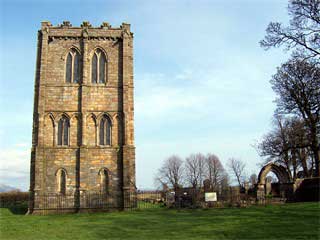IN THE FOOTSTEPS OF DAVID R. ROSS "STIRLING" |
Stirling Castle |
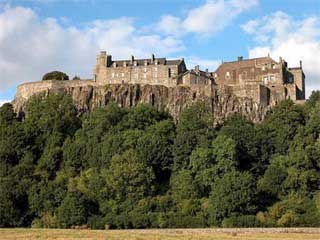 |
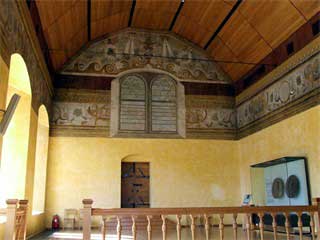 |
I had been to Stirling many many times before but never really explored the place in detail. Once again using my trusty copy of DESIRE LINES as reference, I set off towards the castle itself to start with. |
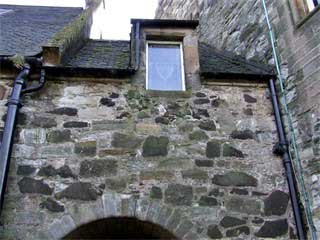 |
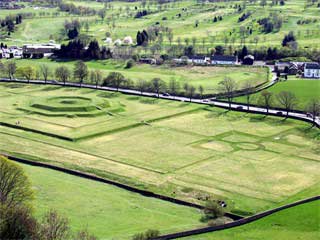 |
Many important events from Scotland's past took place at Stirling Castle, including the violent murder of the eighth Earl of Douglas by James II in 1452. |
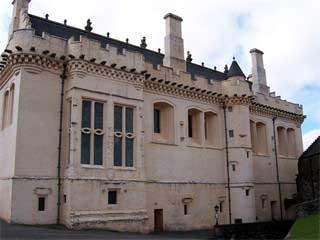 |
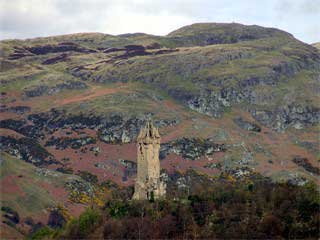 |
The vast Great Hall, which dates from the end of the Middle Ages, has been restored to its medieval glory. Built by James IV in 1503, it was converted to a four storey military barracks in the 19th Century. The Hall has been restored with a new oak hammer beam roof which looks magnificent. When the scaffolding came down, the colour and finish of the hall was the subject of some controversy but I quite like it. Many thought that the building had been over-decorated. It was eventually accepted that this is how the original building might have looked and it is now widely admired for it's magnificence on the Stirling skyline. In the gardens is a mound of earth, in the form of a table, known as "The Knott,"or "Round Table," Barbour, in his account of the battle of Bannockburn, makes mention of the same, he says, that, when Edward of England was told by Mowbery, the governor, that he could not expect safety by being admitted into the castle, "he took the way beneath the castle by the round table." It is, undoubtedly, of great antiquity, and must have been in that place long before the gardens were formed. |
The Monument |
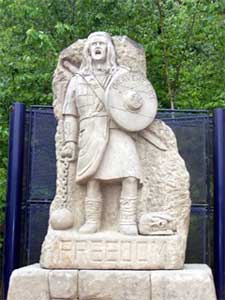 |
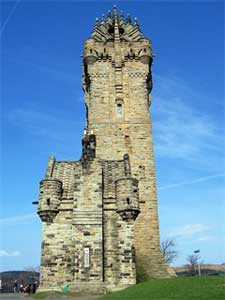 |
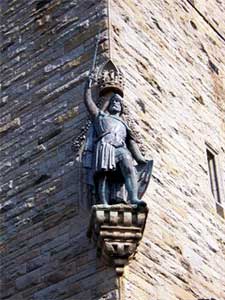 |
When you first arrive at the Wallace Monument you can't help but wonder what kind of man deserved the building of such a grand monument, that man was of course Wallace and personally I don't think it could ever be big enough!!! |
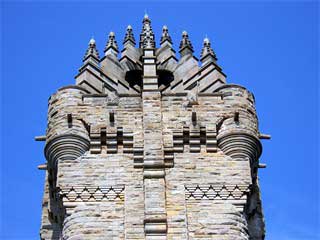 |
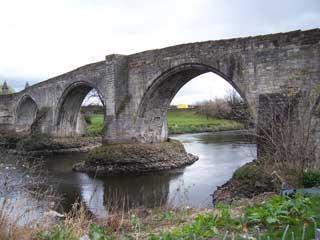 |
Once up at the monument itself you can really take in the beauty of the structure. It was designed by John T. Rochead, the foundation stone was laid on Bannockburn day 1861 where 80,000 people, yes you heard me, 80,000 people were there to watch. |
Cambuskenneth Abbey |
|
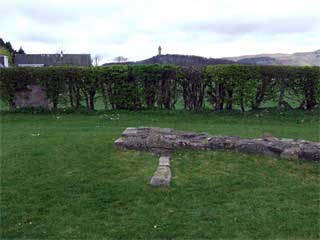 |
One of the things I discovered thanks to "Desire Lines," was a wee place just down the road from the monument called Cambuskenneth Abbey. Wow!! what a place. Cambuskenneth lies directly to the east of Stirling. The village is quite secluded from Stirling with one road in and out, directions for the abbey itself are well signposted. |
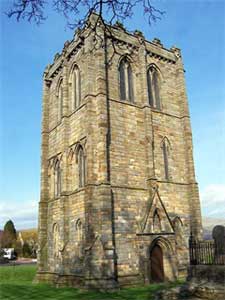 |
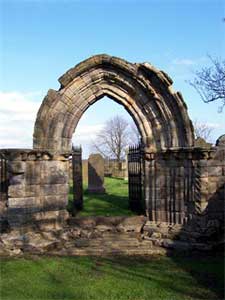 |
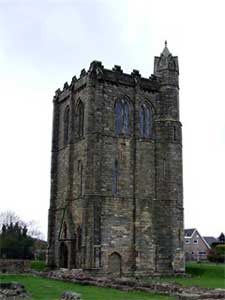 |
At its height at the end of the 1200s Cambuskenneth comprised an extensive complex of buildings. This included a large abbey church. To its south was the usual cloister surrounded by ranges of domestic buildings. Between the cloister and the river to its east stood secondary ranges of buildings and a wharf. Cambuskenneth's closeness to Stirling Castle gained it few favours from passing English armies during the Wars of Independence from the end of the 1200s. By 1378 the abbey church was reported to be in ruins. It was rebuilt during the early 1400s and once again used by Scotland's royalty. |
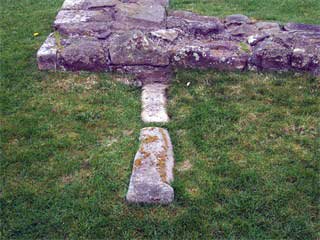 |
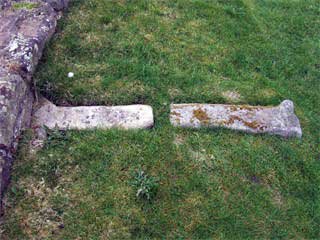 |
But perhaps the most interesting part of any visit to the abbey is the least obvious. There is a local legend that Wallace's left arm is interred here and a stone is pointed out as the place. |
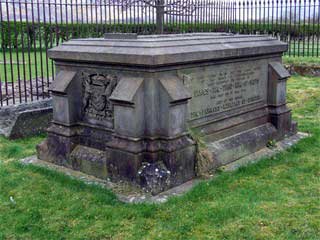 |
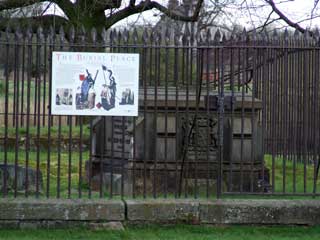 |
More To See |
Stirling has got to be one of my favourite places in Scotland to visit. The places I've mentioned above are three of my personal favourites, but there's so much more to see. |
The Battle of Stirling Bridge - Factsheet |
"For this reason the Scots adopted a stout heart at the instigation of William Wallace, who taught them to fight, so that those whom the English nation held as living captives might be made renewed Scots in their own homeland,...
Hence in the year one thousand three hundred less three time one the Scots vanquished the English, whom they put into mourning for death, as the bridge bears witness, where the great battle is recorded, which lies beyond Stirling on the River Forth." |
Poem in Bower’s Scotichronicon on the Battle of Stirling Bridge |
 |
September 1297 |
John de Warenne marches north with a huge force of cavalry and infantry. Earl of Surrey, Govenor in Scotland for Edward I of England, and spearhead of his imperial ambitions north of the border, he is confident of victory, whether by battle or negotiation. It has been four months since the rising of William Wallace and Andrew Murray began. Near Stirling Castle he arrives at a narrow, wooden bridge which crosses The River Forth. There, on the opposite bank is Wallace and Murray’s army. Warenne delays his crossing for several days to allow for negotiations, cocksure that the Scots will choose peace over war in the light of recent English victories and their obvious military superiority. He is surprised by their refusal to surrender and on the 11th September decides to force the crossing. |
The Strategic Situation |
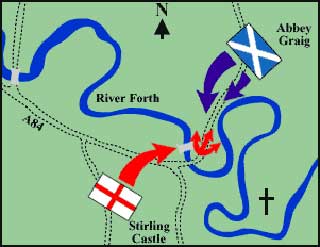 |
The town of Stirling was the key entry point to the north of Scotland. The tidal River Forth was too wide to cross east of the town and upstream lay the enormous bog of The Carse of Gowrie. The Scots were encamped on the Abbey Craig, where the National Wallace Monument stands today. Their army was predominantly infantry armed with long spears, and was drawn mainly from the ‘lesser’ ranks of society - not because the Scots nobles completely resisted Wallace, but because many of them were being held captive in England. From the base of Abbey Craig a causeway stretched for a mile across The River Forth’s flood plain (roughly in line with the present day road between The Craig and the river). At the end of the causeway stood the bridge (lying 180 yards upstream from the 15th century stone that still crosses the river today It was wide enough to pass with only two horsemen abreast and the entire English |
army would have taken several hours to cross, after which they would have to enter a confined narrow loop in the river, leaving their flank dangerously exposed to attack. All this before they were even ready to give battle. |
Battle of Stirling Bridge, 11th September 1297 |
At dawn the English and Welsh infantry start to cross only to be recalled due to the fact that their leader, Warenne, has overslept. Again they cross the bridge and again they are recalled: as Warenne believes the Scots might finally negotiate. Two Dominican friars are sent to Wallace to acquire his surrender and return shortly afterwards with William Wallace's first recorded speech: |
"Tell your commander that we are not here to make peace but to do battle, defend ourselves and liberate our kingdom. Let them come on, and we shall prove this in their very beards." |
Warenne decides to advance. He is advised to send a cavalry force upstream to The Ford of Drip in order to cover the infantry’s crossing, however Edward’s treasurer, Hugh de Cressingham, intervenes, pointing out that too much of the king’s money has already been wasted and insisting that they cross at once to bring the campaign to a swift end. Wallace and Murray wait until more than half the English army has crossed the bridge before springing their trap. The Scots spearmen rush down the causeway. Those on the right flank force their way along the river bank to the north end of the bridge, cutting off any hope of escape. Trapped in a confined space with the river to their backs the English heavy cavalry is virtually useless. Only one group of English knights, under Sir Marmaduke Tweng, succeed in cutting their way back to the bridge. After they have crossed, Warenne, who has wisely stayed put, has the bridge destroyed and flees to Berwick. Over half the English army is left to its fate on the Scots side of the river. Those that can swim do so, the rest (over 100 men-at-arms and 5,000 infantry) are inevitably massacred. Many of them are Welsh, but among them isHugh de Cressingham, Edward’s hated tax collector, who had crossed first. On the Scots side, Andrew Murray is fatally wounded. He dies two months later and is buried at Fortrose Cathedral on Black Isle, north of Inverness. Victory brings the collapse of English occupation. Wallace, now Guardian of Scotland, goeson to devastate the north of England in the hope of forcing Edward to acknowledge defeat. Records show that 715 villages are burnt and many helpless people are no doubt slain. The cycle of brutality, started by Edward at Berwick, rolls remorselessly on. |
Significance |
Until 1297 the heavily armed and mounted knight had been an invincible force on the battlefield. Stirling Bridge was the first battle in Europe to see a common army of spearmen defeat a feudal host. Only five years later a host of French knights were to go down to similarly-armed Flemish townsmen at The Battle of Courtrai. Stirling Bridge also destroyed the myth of English invincibility. The Scots had not defeated a major English army since the Dark Ages, but this victory seems to have strengthened their will to resist Edward I. However, the humiliation of losing to lowly Scots only strengthened Edward’s determination: under a year later Wallace’s Scots Army were defeated at The Battle of Falkirk. |
 |
© Paisley Tartan Army 2008-09

